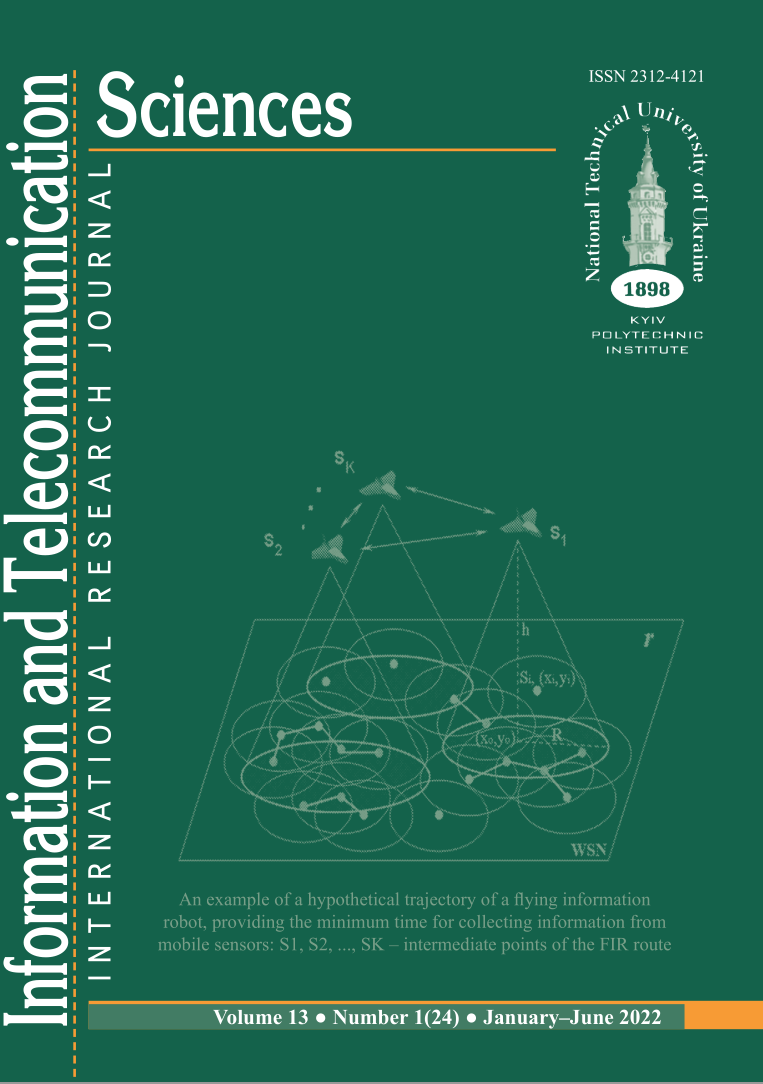ANALYSIS OF DIFFERENCES IN THE CHARACTERISTICS OF QUEUING SYSTEMS WITH THE DYNAMICS OF INPUT STREAMS SELF-SIMILARITY
DOI:
https://doi.org/10.20535/2411-2976.12022.22-26Keywords:
queuing system, quality of service, Poisson distribution, Weibull distribution, self-similarityAbstract
Background. Modern queuing theory is used in many fields and in telecommunications it plays an important role. Today, the modern way to implement queuing systems is a cloud environment. And the main problem of queuing system is to ensure the quality of service.
Objective. The purpose of the paper is to study the indicators of service quality of queuing systems with different initial characteristics, to analyse the service quality characteristics when comparing quantitative characteristics of different parameters of queuing systems to identify features of queuing system with self-similarity.
Methods. Analyse the theory of QoS, types of distribution, such as Poisson and Weibull, as well as the properties of self-similar traffic. Compare the values of the main parameters that provide the desired quality of service at different inputs and different Hearst parameters.
Results. The importance of taking into account the self-similarity factor for the accuracy of the values of the parameters in the calculation that ensure the quality of service in the QMS.
Conclusions. Research of the influence of self-similar traffic on the quality of service in queuing systems.
References
Erlang, Agner K., The Theory of Probabilities and Telephone Conversations, in The Life and Works of A.K. Erlang, by Brockmeyer, E.; Halstrøm, H. L.; Jensen, Arne (eds.), Transactions of the Danish Academy of Technical Sciences, 2, Akademiet for de Tekniske Videnskaber, 1909, pp. 131-137.
A. Kryklyva, “Analysis of the influence of the properties of self-similar traffic on the quality of service“, XІІІ International scientific and technical conference of students and graduate students "Prospects for the development of information and telecommunications technologies and systems" PRITS-2021: Proceedings of the conference – K .: Igor Sikorsky Kyiv Polytechnic Institute, p.390, 2021.
I. Strelkovskaya, I. Solovskaya, A.Makoganiuk, “Optimization of QoS characteristics of self-similar traffic “, Problems of Infocommunications 169 Science and Technology: conference proceedings of the 2017 4th International Scientific-Practical Conference Proceedings (PICS&T 2017), p.497-500, Kharkiv, Ukraine, Oct. 10-13, 2017. https://doi.org/10.1109/INFOCOMMST.2017.8246447. (Scopus)
I. Strelkovskaya, I. Solovskaya, A. Makoganiuk, A. Balyk, “Research of the quality characteristics of self-similar traffic of a mobile communication network on the basis of software release”, International Research Journal. Information and telecommunication sciences: Volume 11 Number 2(21), p. 51-57, Jul.-Dec. 2020.
Kleinrock L., Queueing Systems, Vol. I, II, John Wiley & Sons, 1975
Giambene G., Queuing Theory and Telecommunications: Networks and Applications, Giovanni Giambene. –Springer, 2014.
Little, J.D.C., “A Proof for the Queueing Formula L = λW”, Operations Research, Vol. 9, 1961, pp. 383–387.
I. Strelkovskaya, T. Grigorieva, I. Solovskaya, “Service of self-similar traffic in G / M / 1 queuing systems with Weibull distribution”, Proceedings of universities. Radioelectronics, v.61, № 3, 2018, pp.173 – 178.
L. Uryvsky, A. Kryklyva, “Research of service indicators dynamics in queuing system with self-similar traffic”, ХVI International scientific and technical conference "Prospects for the development of information and telecommunications technologies and systems" PRITS-2021: Proceedings of the conference. – K .: Igor Sikorsky Kyiv Polytechnic Institute, pp.53-58, 2022.
Downloads
Published
How to Cite
Issue
Section
License
Copyright (c) 2022 Leonid Uryvsky, Anastasiia Kryklyva

This work is licensed under a Creative Commons Attribution 4.0 International License.
The ownership of copyright remains with the Authors.
Authors may use their own material in other publications provided that the Journal is acknowledged as the original place of publication and National Technical University of Ukraine “Igor Sikorsky Kyiv Polytechnic Institute” as the Publisher.
ITS articles are published under Creative Commons licence:
- Authors retain copyright and grant the journal right of first publication with the work simultaneously licensed under CC BY 4.0that allows others to share the work with an acknowledgement of the work's authorship and initial publication in this journal.
- Authors are able to enter into separate, additional contractual arrangements for the non-exclusive distribution of the journal's published version of the work (e.g., post it to an institutional repository or publish it in a book), with an acknowledgement of its initial publication in this journal.
- Authors are permitted and encouraged to post their work online (e.g., in institutional repositories or on their website) prior to and during the submission process, as it can lead to productive exchanges, as well as earlier and greater citation of published work.

